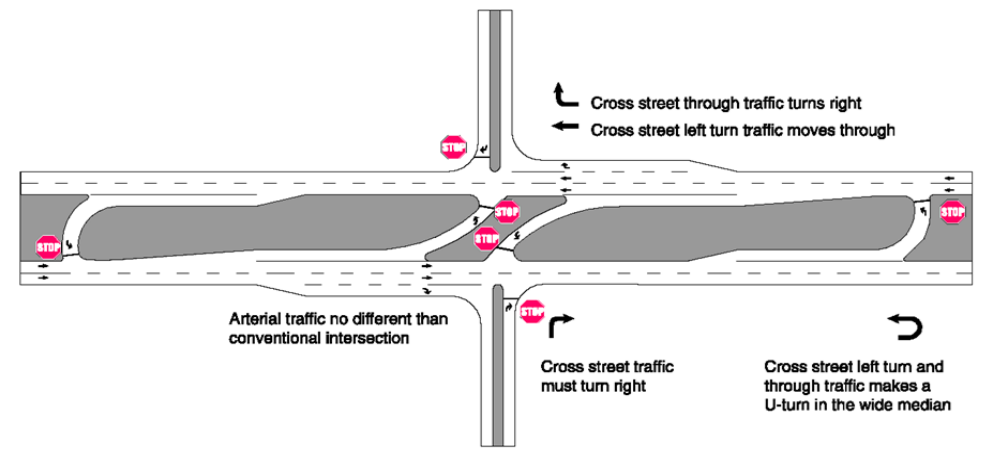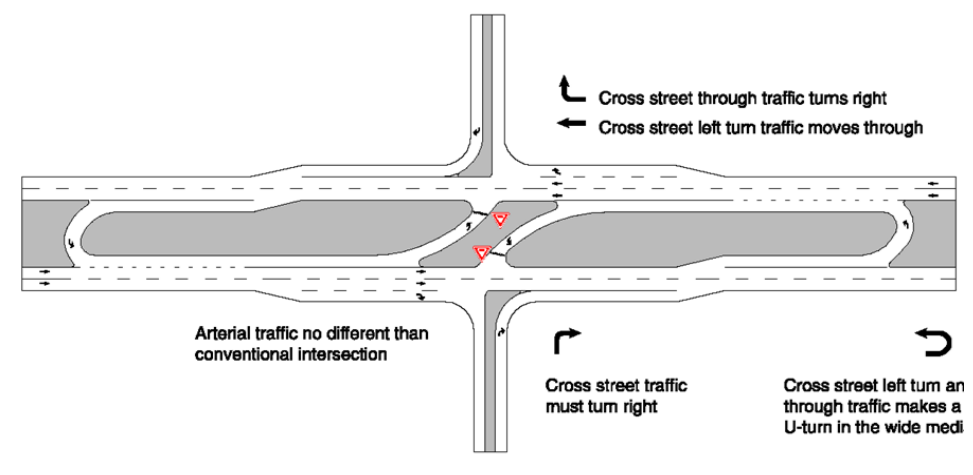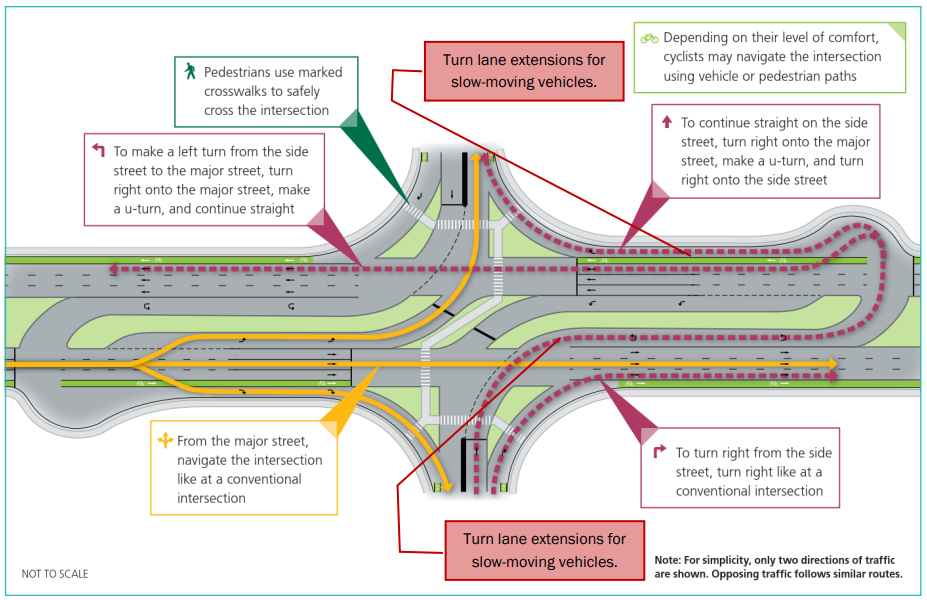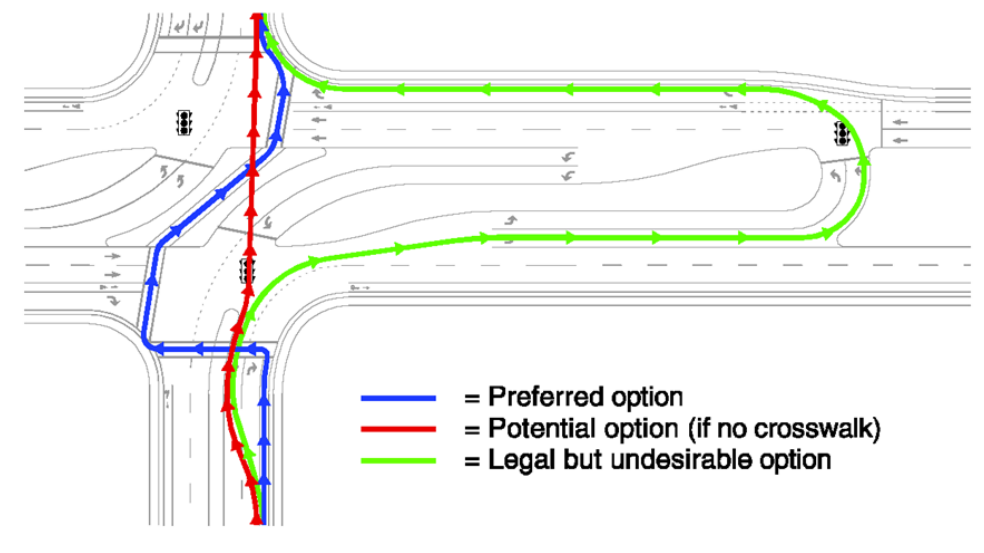14.6 Restricted Crossing U-Turn Intersection (RCUT)
14.6.1 Overview
The RCUT, also known as a J-turn or superstreet intersection, is an at-grade intersection with directional medians such that all minor road traffic makes a right-turn followed by a U-turn back to cross a designated location which can be either signalized or unsignalized. The benefits of the RCUT include a significant reduction in intersection conflict points, and a reduction in crash rates and severity. TxDOT has adopted the
as the primary source for RCUT Guidelines. The information contained in this section is considered a companion guide and is intended to document TxDOT’s suggested approach to RCUT design.
See
through
for examples of RCUTs with signals, without signals, and with merges. For RCUT 3-leg approaches, refer to Chapter 7 of the
.

Figure 14-16: Example of RCUT Intersection with Signals
Source: FHWA RCUT Informational Guide

Figure 14-17: Example of RCUT Intersection with Stop-Control
Source: FHWA RCUT Informational Guide

Figure 14-18: Example of RCUT Intersection with Merges
Source: FHWA RCUT Informational Guide
Applications of an RCUT intersection include minor road intersections along rural four lane divided highways, as an alternative to signalization at select intersections to maintain throughput of the main highway, as a corridor treatment along signalized routes to minimize travel times, and as an interim alternative to constructing a grade separated interchange. RCUTs may not be suitable at locations where the minor crossing street has a high volume of left-turn movements, or where there are multiple private drives near the intersection.
14.6.2 Design Considerations
The spacing of the RCUT crossovers from the intersection is central to the proper functioning of the intersection. The typical location for the median opening at an RCUT intersection with stop sign or signal control is 400-ft to 800-ft. downstream of the minor road.
The median width is a function of the design vehicle (typically a WB-62TX or WB-67) and the preferred alignment of the design vehicle as it turns into the opposing traffic; see
for discussion on Median U-Turn Movements. For instances where the U-turn can’t be completed using the existing pavement, a loon type configuration with back-to-back storage bays may be used to provide additional space. See
and
for spacing considerations for a minor street through or left movement. Designers must also ensure good intersection sight distances at RCUT crossovers by making sure slopes and plantings in the median are cut back beyond the lines of sight.
illustrates an RCUT scheme showing the extension of left-turn lane deceleration for the left-turn lane and for the acceleration lane after a vehicle exits the U-turn loon. These features are preferred for slow moving vehicles such as trucks and farm equipment that cannot accelerate and decelerate in the distance available between the RCUT and the U-turn. This design concept also affords placement of the U-turn closer to the RCUT. Making it possible to compress the overall footprint with potential space and cost savings.

Figure 14-19: Spacing Consideration for a Minor Street Through or Left Movement
Source: FHWA RCUT Informational Guide

Figure 14-20: Spacing Consideration for a Minor Street Through or Left Movement
Source: FHWA RCUT Informational Guide
Source: VDOT website, accessed March 5, 2024 (used by permission)
14.6.3 Intersection Angle
The angle of the side roads to the main lanes of an RCUT intersection can have an impact on traffic operations and the conversion from a conventional intersection to an RCUT intersection. RCUT intersections at an acute angle (less than 90 degrees) generate left-turn movements more effectively with the major street as opposed to an obtuse angle (greater than 90 degrees).
demonstrates this concept.

Figure 14-21: RCUT Intersection Angle Considerations
14.6.4 Pedestrian and Bicyclist Considerations
RCUTs have benefits for pedestrians, which include a reduction in the number of conflict points and a reduction in cycle lengths (when signalized) by simplifying vehicular movements and eliminating left-turns. However, pedestrians and bicyclists traversing an RCUT intersection have safety challenges as well, similar to a MUT intersection. In general, an RCUT is better suited for relatively low pedestrian activity or, at least, relatively low volumes of pedestrians crossing the major street. The primary pedestrian crossing pattern is shown in
. The
provides guidance for additional pedestrian crossing alternatives.

Figure 14-22: Pedestrian Movements in a RCUT Intersection
Source: FHWA RCUT Informational Guide
Bicyclists on the major roadway travel through the RCUT the same way they travel through a conventional intersection. The options available for bicyclists approaching on the minor street are:
- Bicyclists follow pedestrian crossing rules (preferred option): Bicyclists approach the intersection and exit the street to the right and follow the pedestrian (“walk” /” don’t walk”) indications;
- If no crosswalk is available, a potential option is for the bicyclist to pass through/across the channelizing island; and
- Bicyclists following vehicle rules (legal but undesirable option): Bicyclists approach the intersection on the right and follow the vehicle signal indications. This option is legally permissible, but undesirable.
Ultimately, a thorough site assessment, an assessment of anticipated bicycle and pedestrian volumes, and an assessment of projected origins and destinations for pedestrians and bicyclists should be conducted to determine the preferred method of movement through the RCUT.
depicts the three options.

Figure 14-23: Minor Street Through Options for Bicycles
Source: FHWA RCUT Informational Guide
14.6.5 Access Management
From an access management standpoint, possible advantages of an RCUT include the following:
- Can provide a U-turn movement for multiple side streets along the RCUT corridor;
- Allows flexibility for crossover locations to accommodate adjacent driveways and side streets; and
- Provides significant progression benefits along the corridor, which can allow for speed control using the signals.
Possible disadvantages include:
- Not allowing driveways or side streets near entrances to U-turn crossovers; and
- Not having driveways with direct left-turns.
In general, avoid access points for 100-ft. on either side of the entrance to a U-turn crossover. Refer to the
for additional guidance with respect to access management.
14.6.6 Safety
RCUT intersections have safety benefits due to reduced conflict points, especially crossing conflict points, resulting in fewer severe crashes. Potential safety issues to consider at RCUT intersections include:
- Conflicts where U-turns are aligned with driveways;
- The need for channelization to prevent wrong-way movements;
- Where U-turns are made with highspeed opposing vehicles;
- The increased chance of deceleration lane spillback; and
- The potential for weaving movements on the major street.
For additional information on safety refer to the
.
14.6.7 Operations
RCUT intersections may be signalized or unsignalized. It is only recommended to implement an unsignalized RCUT at a rural intersection. One unique operational benefit of a signalized RCUT is that the signalization of each direction of travel on the major road can operate independently. For more information on operations refer to the
.
14.6.8 Traffic Control Devices
RCUT intersections require clear traffic control devices to guide drivers through the intersection. The four main objectives of traffic control devices in RCUT intersections are:
- Provide signage and pavement markings to prohibit left-turns and alternative routing of left-turn movements;
- Provide one-way and wrong-way signage;
- Provide a means for safe bicycle and pedestrian crossings; and
- Provide appropriate safety lighting at conflict points.
Refer to the
for further guidance on traffic control devices. The
remains the primary source for traffic control device standards.